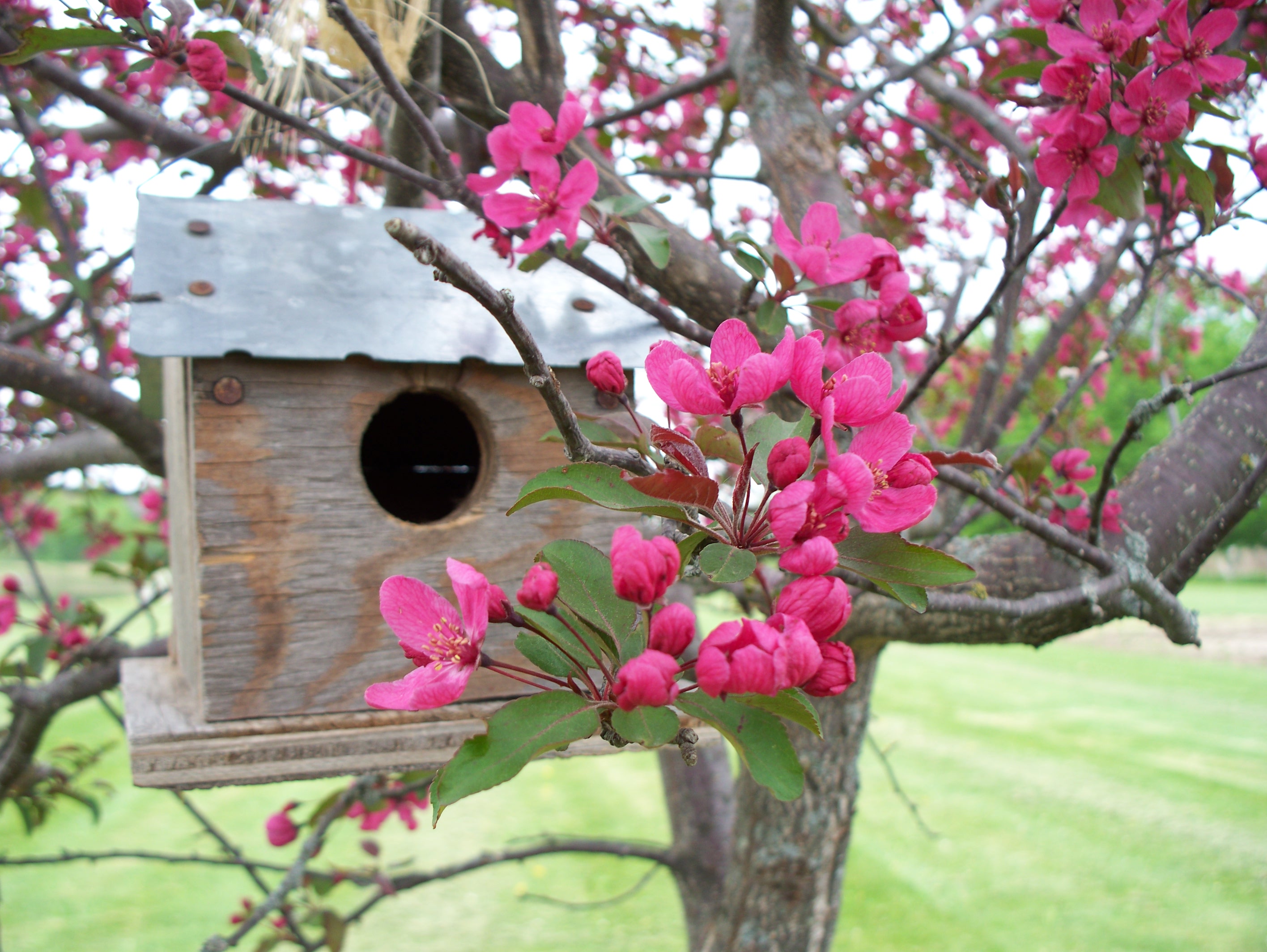Interactions
Tree Swallows interact with a diverse array of organisms both predatory and
benign. They interact with organisms through everyday life of competition
of nest sites, predation, ectoparasites, and interaction with the environment.
Tree Swallows’ high reproduction rate helps make up for loses from predation,
disease, and weather.
●
Other Organisms That Tree Swallows Interact With
●
Predators
●
Disease
●
Competition with Other Birds
●
Competition with Other Tree Swallows
●
Environment
●
Humans
Other Organisms That Tree Swallows Interact With
Tree Swallows live along side an array of different
or.jpg) ganisms.
Many include
white-tail deer, squirrels, chipmunks,
monarch butterflies, turkeys, brown-headed cowbirds,
red winged black birds, cardinals, baltimore orioles,
ruby-throated hummingbirds, yellow finches, purple finches, house wrens,
blue birds, robins, blue jays, house sparrows, chickadees, and many others.
They also live with a variety of tree species in which they build their nests
inside and various other plant species.
ganisms.
Many include
white-tail deer, squirrels, chipmunks,
monarch butterflies, turkeys, brown-headed cowbirds,
red winged black birds, cardinals, baltimore orioles,
ruby-throated hummingbirds, yellow finches, purple finches, house wrens,
blue birds, robins, blue jays, house sparrows, chickadees, and many others.
They also live with a variety of tree species in which they build their nests
inside and various other plant species.
Like for all creatures, predation is a way of everyday
 life
for
Tree Swallows. Like was already mentioned, high reproduction rates help
make up for losses. In fact, most losses occur at the time when the young
leave the nest. This occurs because they are weak and inexperienced which
makes them easy prey. For those that make it to adulthood must fight to survive
and must become strong and fit for their own good. If they do not they
will not survive.
life
for
Tree Swallows. Like was already mentioned, high reproduction rates help
make up for losses. In fact, most losses occur at the time when the young
leave the nest. This occurs because they are weak and inexperienced which
makes them easy prey. For those that make it to adulthood must fight to survive
and must become strong and fit for their own good. If they do not they
will not survive.
Some of the biggest predators to Tree Swallows are
domestic cats,
hawks,
kestrels, snakes, raccoons, opossums, weasels, squirrels, black birds, and many
more. These organisms will capture and eat adult tree swallows and will
kill their young or eggs right from the nest. Even the most adept adult
flyers can be attacked and killed by hawks and kestrels.
Like other birds, Tree Swallows can be susceptible to a whole variety of
diseases.
2.jpg) The disease can be caused by bacteria, protozoa, viruses, or ectoparasites.
West Nile Virus can even affect Tree Swallows. Others could be
susceptible to disease due to wasp stings, ectoparasite infestation, birth
defects, environmental factors, or injury.
The disease can be caused by bacteria, protozoa, viruses, or ectoparasites.
West Nile Virus can even affect Tree Swallows. Others could be
susceptible to disease due to wasp stings, ectoparasite infestation, birth
defects, environmental factors, or injury.
Young nestlings are weak and may not be able to cope with parasites that raid
the nest. These ectoparasites, parasites found outside of the body,
include blowfly larvae, fleas, lice, and mites. The picture on the right
shows an example of a bird louse. They affect adult Tree
Swallows as well, but death usually results indirectly when these ectoparasites
are brushed off the adults and land on the nestlings. These parasites
indirectly cause death to nestlings because they don’t just kill the babies out
of the blue, but they weaken their immune system making them very susceptible to
contracting all sorts of disease.
Many times Tree Swallow nests will be infested with ectoparasites.
Blowflies and mites pose problems because they suck the blood of the infected
individual. They are easily transmitted from adults to the young because
they are always in contact with each other. Mites in fact can jump
from individual to individual.
Competition is high for all birds, but for Tree
 Swallows
it is especially hard when available cavities are limited. Their biggest
competition comes from European starlings, house sparrows, house wrens, and
bluebirds, but they will even compete for nest sites with chickadees,
owls,
and kestrels. All these species nest in cavities as well and will take
Tree Swallow’s nest sites at all costs. Many of these species will kill
the adults, kill their eggs, and kill the hatched nestlings.
Swallows
it is especially hard when available cavities are limited. Their biggest
competition comes from European starlings, house sparrows, house wrens, and
bluebirds, but they will even compete for nest sites with chickadees,
owls,
and kestrels. All these species nest in cavities as well and will take
Tree Swallow’s nest sites at all costs. Many of these species will kill
the adults, kill their eggs, and kill the hatched nestlings.
 Sometimes, because Tree Swallows can be very small compared to other birds,
bigger birds like starlings, owls, and kestrels will not be able to raid the
nest because they will not be able to enter some of the entrances to the
cavities. This is the main reason why when building a birdhouse you make
the entrance hole 1 ½ inches in diameter. This will lower the competition
for tree swallows.
Sometimes, because Tree Swallows can be very small compared to other birds,
bigger birds like starlings, owls, and kestrels will not be able to raid the
nest because they will not be able to enter some of the entrances to the
cavities. This is the main reason why when building a birdhouse you make
the entrance hole 1 ½ inches in diameter. This will lower the competition
for tree swallows.
But, you will have birds that will be able to
 get
into
these entrance holes. wrens, house sparrows, and bluebirds are able to do
just that. Bluebirds are much larger than Tree Swallows and can cause
damage. They will destroy the nest and will outcompete Tree Swallows.
Wrens, even though small, can cause their damage by removing or destroying Tree
Swallow eggs. House sparrows compete by killing adult Tree Swallows and building
their nests over top of the Tree Swallows nest.
get
into
these entrance holes. wrens, house sparrows, and bluebirds are able to do
just that. Bluebirds are much larger than Tree Swallows and can cause
damage. They will destroy the nest and will outcompete Tree Swallows.
Wrens, even though small, can cause their damage by removing or destroying Tree
Swallow eggs. House sparrows compete by killing adult Tree Swallows and building
their nests over top of the Tree Swallows nest.
Competition with Other Tree Swallows
Just as Tree Swallows compete with other species of
birds, they also compete with those within their own species. Pairs will compete with each other for nest sites and many will die in the battle.
Commonly, birds will compete for nest sites even when territories have been
established. Many times adults that are not in pairs will kill nestlings
when they want to take over that nest.
with each other for nest sites and many will die in the battle.
Commonly, birds will compete for nest sites even when territories have been
established. Many times adults that are not in pairs will kill nestlings
when they want to take over that nest.
Male tree swallows, when they want to replace a dead male, will kill all the
former young in that nest. By killing these young the male tree swallow
will be able to have his own children and reduce competition in the future from
the other male Tree Swallow’s children. Female Tree Swallows may do the same so
they can get nest sites.
Environment
The environment can be very rough on any creature.
 Tree Swallows may be
threatened by environmental affects causing hypothermia or starvation.
If it is raining constantly during the spring or summer, it can get cold and wet
very quickly and will affect these birds extremely. On top of that if it is windy, available insects
that Tree Swallows feed on could be lowered. This would not only cause
starvation in the adult Tree Swallows but will inadvertently cause starvation
and hypothermia in their young.
Tree Swallows may be
threatened by environmental affects causing hypothermia or starvation.
If it is raining constantly during the spring or summer, it can get cold and wet
very quickly and will affect these birds extremely. On top of that if it is windy, available insects
that Tree Swallows feed on could be lowered. This would not only cause
starvation in the adult Tree Swallows but will inadvertently cause starvation
and hypothermia in their young.
 Both parents bring food to the hatched young and if one parent dies, the
other parent must fend for all the babies. If there is a case when all six
babies survive after hatching that parent has a huge burden on their shoulders.
Because one parent is not able to feed all the nestlings by themselves, the
weakest will starve. In hope, the stronger young will live.
Both parents bring food to the hatched young and if one parent dies, the
other parent must fend for all the babies. If there is a case when all six
babies survive after hatching that parent has a huge burden on their shoulders.
Because one parent is not able to feed all the nestlings by themselves, the
weakest will starve. In hope, the stronger young will live.
Just as the environment may be affected by
 humans,
so too can those organisms that live in it. Many times Tree Swallows, like
other organisms, can be poisoned or killed when their food supply is
contaminated by pesticides or pollutants. Sometimes, if people bother the
nests too much the parents could even desert the nests do avoid danger on
themselves. When nest sites are built too close to roads, as they take
away much of its habitat, Tree Swallows could be threatened by collisions with
automobiles.
humans,
so too can those organisms that live in it. Many times Tree Swallows, like
other organisms, can be poisoned or killed when their food supply is
contaminated by pesticides or pollutants. Sometimes, if people bother the
nests too much the parents could even desert the nests do avoid danger on
themselves. When nest sites are built too close to roads, as they take
away much of its habitat, Tree Swallows could be threatened by collisions with
automobiles.
By clicking
Other Related Species you can learn about the other species under the genus
Tachycineta. Click here to return return
to the Tree Swallow:Tachycineta bicolor Homepage.
.jpg)
.jpg)